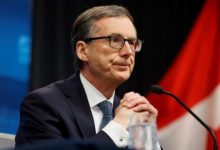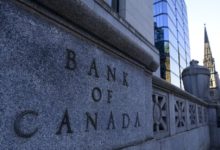Bank of Canada holds benchmark interest rate steady at COVID-19 low, but slows down other stimulus

The Bank of Canada kept its benchmark interest rate steady at 0.25 per cent on Wednesday, noting that while the economy is improving in line with vaccinations, the spectre of coronavirus variants makes the recovery uncertain.
Canada’s inflation rate rises to highest level in a decade, at 3.6%
Canada’s central bank said Wednesday that it has no plans to raise its benchmark interest rate, known as the target for the overnight rate, until Canada’s inflation rate shows signs of settling in at around two per cent.
Official data shows the inflation rate is currently at its highest level in a decade at 3.4 per cent, but the bank thinks that spike is only temporary and will come back into a more normal range once “transitory” imbalances in things like supply and demand for consumer goods, shipping bottlenecks and a global shortage of semiconductors level off.
“In the Bank’s July projection, this happens sometime in the second half of 2022,” the bank said, which means it expects to keep its rate right where it is for about another year at least.
“The global economy is recovering strongly from the COVID-19 pandemic, with continued progress on vaccinations, particularly in advanced economies. However, the recovery is still highly uneven and remains dependent on the course of the virus.”
The bank’s benchmark rate impacts the rates that borrowers and savers get from retail banks on things like variable rate mortgages, lines of credit and savings accounts. All things being equal, the central bank cuts its rate when it wants to encourage spending and investment to stimulate the economy. It raises it when it wants to cool down inflation.
Removing some stimulus
While the bank’s decision Wednesday makes it clear it’s comfortable keeping its rate steady, it is still taking its foot off the stimulus gas pedal in other ways.
In the early days of the pandemic, the bank created a series of bond-buying programs that all had the aim of maintaining the supply of money and keeping lending cheap for banks so they could pass on those savings to consumers. Known as “quantitative easing,” the central bank has added hundreds of billions of dollars to its balance sheet via the programs.
So-called QE stimulates the economy by making sure credit-worthy borrowers have access to cash, and making sure banks have enough on hand to lend to anyone that needs it.
When they started the programs in April of 2020, the bank pledged to buy up at least $5 billion a week worth of bonds. That later became up to $5 billion a week, and by the last time the bank met, it had slowed those purchases to $3 billion a week. On Wednesday, it slowed the pace again, down to $2 billion a week.
That won’t have a dramatic impact on consumers or borrowers, but it is a signal that Canada’s central bank thinks it’s time to start thinking about how to slowly unwind some of the emergency measures put in place to deal with the unprecedented pandemic.
“Decisions regarding further adjustments to the pace of net bond purchases will be guided by Governing Council’s ongoing assessment of the strength and durability of the recovery,” the bank said. “We will continue to provide the appropriate degree of monetary policy stimulus to support the recovery and achieve the inflation objective.”
Reaction
Economist Sri Thanabalasingam with TD Bank says the slow, cautious unwinding of the bank’s bond-buying program makes sense.
“With the economic recovery strengthening on the back of easing public health restrictions, it was a prudent move by the Bank to remove some policy support,” he said.
But the bank is still making it clear the economy is still nowhere near normal, he said.
“The Bank of Canada will not be turning off the taps anytime soon,” he said. “It will take time for a full and inclusive recovery in employment, especially as workers take on new jobs.”
Economist Doug Porter at BMO said he thinks the bank will slow its bond purchases steadily.
“We expect the tapering process to continue apace, with the Bank winding down its QE by early next year,” he said.”This will set the stage for rate hikes, likely within the next 12 months of the end of QE — with a good chance of sooner rather than later.”
The market seems to agree, as pricing in investments known as swaps that bet on future rate levels suggests there’s about a one in three chance of a rate hike by October. On balance, though, none are expected until some time in 2022.








Redes Sociais - Comentários